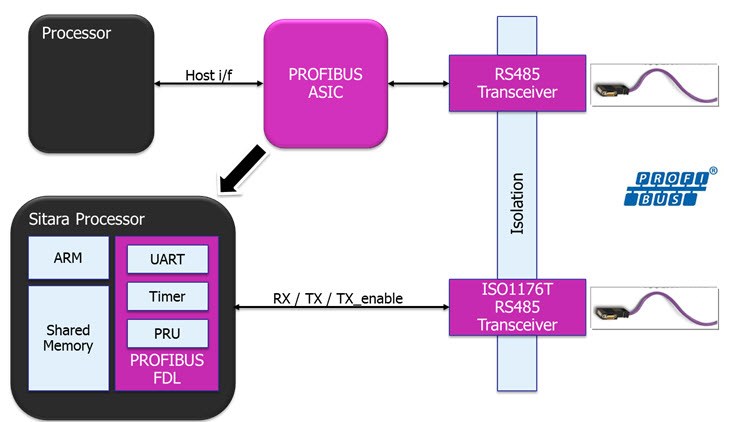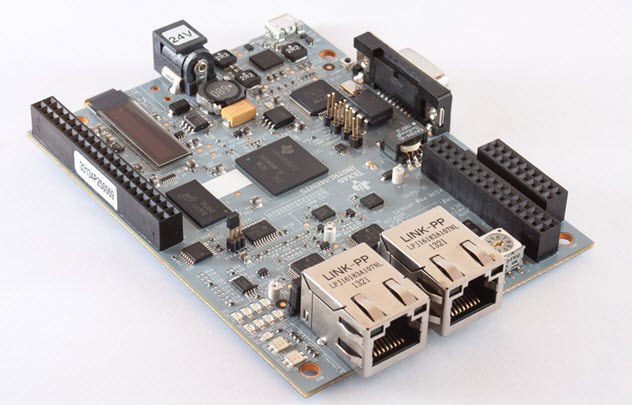SSZTAU7 september 2016 AMIC110 , ISO1176T
Welcome to the sixth installment of “How to select the right industrial Ethernet standard,” a series for designers who have decided to leverage industrial Ethernet in their systems. In this series, I’m covering several common industrial communication protocols to help you select the right standard for your application. In my previous posts, I discussed EtherCAT, Sercos III, PROFINET, EtherNet/IP and Ethernet Powerlink.
Did you already spot what’s not right about this post’s title? PROFIBUS (process field bus) is not based on industrial Ethernet! But because this protocol is quite important even when you already support industrial Ethernet, I decided to continue the series with the same post title.
PROFIBUS belongs to the field-bus protocols that are based on serial communication. It is a mature standard that has existed since 1993. The official organization that drives specifications and coordinates conformance testing is called PROFIBUS and PROFINET International (PI).
Today, there are two variations of PROFIBUS deployed in the area of factory automation and control and process automation:
- PROFIBUS Decentralized Peripheral (DP) supports serial communication of bit rates from 9.6Kbps to 12Mbps. RS-485 is the most common physical layer, while some implementations use optical and Manchester bus powered (MBP). The maximum cable length between the programmable logic controller (PLC) and input and output (I/O) field device is between 100m to 1,200m, depending on the selected bus’ bit rate.
- PROFIBUS Process Automation (PA) supports only a single bit rate of 31.25Kbps. Because it uses the same protocol as PROFIBUS DP, it is possible to mix PA and DP networks.
A PROFIBUS network uses a simple bus topology where the PROFIBUS master communicates with multiple PROFIBUS I/O devices (slaves). The protocol limits the maximum number of PROFIBUS devices to 126. The master polls data periodically from the I/O device. Only the master can initiate a PROFIBUS communication frame to I/O devices. The addressed I/O device must respond to the master’s communication frame within a specified response time. I/O devices cannot initiate a communication frame by themselves to the master.
Many existing I/O device solutions using the PROFIBUS protocol are based on application-specific integrated circuits (ASICs). Because PROFIBUS is already a mature technology, most PROFIBUS ASICs are not based on the latest chip technology – and are therefore quite expensive.
Why should you care about the PROFIBUS protocol if you are already using industrial Ethernet? Because you can implement industrial Ethernet and PROFIBUS with Sitara™ processors and the programmable real-time unit and industrial communication subsystem (PRU-ICSS)
Every April, the PI releases a report about the number of total PROFIBUS nodes; see Figure 1 (the figure uses the German word for nodes, Knoten). As of 2016, there are over 53.7 million PROFIBUS nodes installed, with a node growth rate of 5.5% from 2015.
 Figure 1 Total PROFIBUS nodes since
2001 (image courtesy of PI)
Figure 1 Total PROFIBUS nodes since
2001 (image courtesy of PI)Even though PROFIBUS is a mature protocol, there are great market opportunities, as PROFIBUS has a high attach rate in factory automation and control.
Using Sitara processors with PRU-ICSS support, you can leverage the PROFIBUS DP protocol in your product and combine it with industrial Ethernet protocols. TI offers PROFIBUS DP device firmware for the PRU-ICSS that is PI-certified. In addition, TI also offers PROFIBUS DP master firmware. Both master and device solutions are provided as part of the industrial software development kit (for AM335x, AM437x processors), or the PRU-ICSS Industrial Software (for AM57x processors). The Sitara-integrated PROFIBUS solution eliminates the need for external ASICs – see Figure 2.
 Figure 2 Integrating the PROFIBUS
function of an external ASIC into the Sitara processor
Figure 2 Integrating the PROFIBUS
function of an external ASIC into the Sitara processorEliminating external ASICs means that you can build a platform solution capable of supporting several industrial Ethernet standards (PROFINET, EtherCAT, Ethernet/IP and more) while also supporting the PROFIBUS protocol. You can evaluate and jump-start the development of such platform solutions using the TI TMDSICE3359 industrial communication engine (ICE) evaluation module (EVM) (Figure 3) and TMDXIDK5728 industrial development kit (IDK). Both EVMs use the ISO1176T device, TI’s PROFIBUS transceiver with an integrated transformer.
 Figure 3 TMDSICE3359 industrial
communication engine EVM supporting multiprotocol Ethernet and PROFIBUS
Figure 3 TMDSICE3359 industrial
communication engine EVM supporting multiprotocol Ethernet and PROFIBUSThere are several advantages to integrating the PROFIBUS function into the processor, as it is with the Sitara processor family:
- Reduced cost and printed circuit board (PCB) space, as the external ASIC is no longer needed.
- Fast process data exchange between the PROFIBUS PRU-ICSS firmware and the ARM application processor via the high speed internal data bus.
- Minimized system power consumption with the low-power Sitara processor family.
- Support for multiprotocol industrial communication with one solution platform, by leveraging TI’s industrial Ethernet PRU firmware protocols and PROFIBUS firmware protocol.
For the TMDSICE3359 evaluation board, TI provides the industrial software development kit, which is based on TI-RTOS, TI’s free real-time operating system (RTOS). To jump-start evaluation, you can use the pre-built binary files for the AM335x ICE or the pre-built files for the AM5728 IDK board.
Additional Resources
- Learn more about other industrial communication protocols.
- Download and build your own industrial application with the industrial software development kit.
- Read our blog post on Control-level design challenges in smart factory automation systems